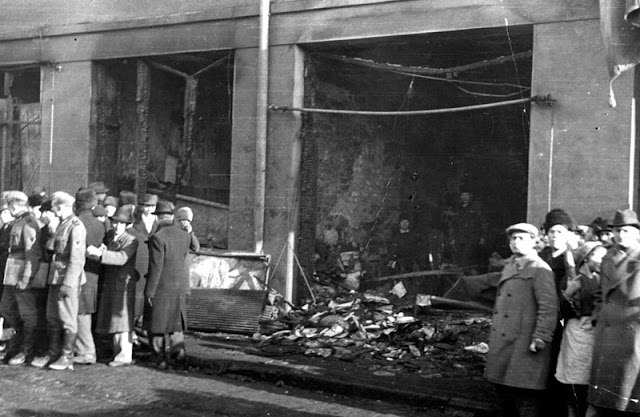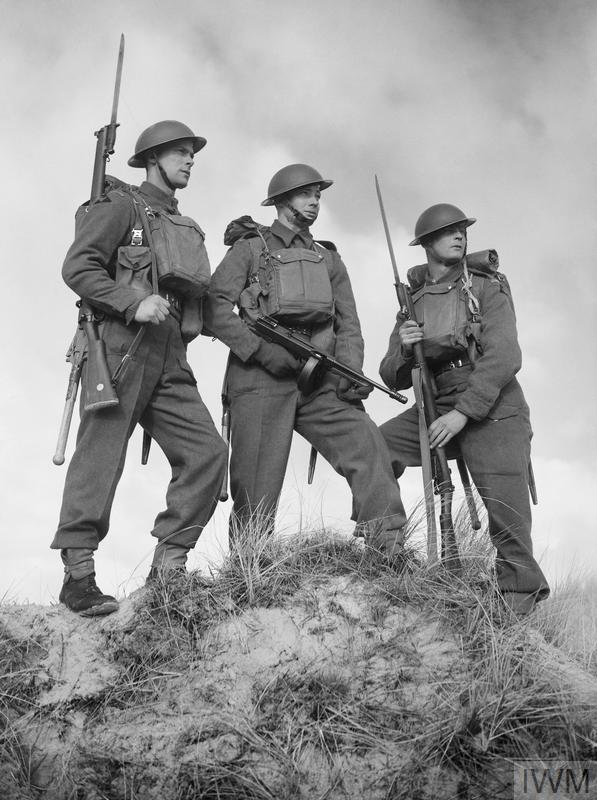Sunday 26 January 1941
 |
| The crew of HMS Wallace with pieces of a Junkers Ju 88 bomber they shot down on 26 January 1941 (© IWM (A 2808)). |
British Prime Minister Winston Churchill sends a long message to his Commander-in-Chief Middle East, General Archibald Wavell, in which he elucidates his growing worries about Greece. He writes that the Germans are:
already establishing themselves upon the Bulgarian aerodromes and making every preparation for action against Greece.Churchill is juggling the competing priorities of Libya and Albania, but it really is a false choice: he has a winning campaign in progress in the former, and basically no chance of affecting the outcome in the latter. He even has admitted recently, to Harry Hopkins, that victory in Greece is impossible against the Germans.
He further writes that:
sustaining of the Greek battle, thus keeping in the field their quite large army [becomes] an objective of prime importance.... [T]he massive importance of taking Valona and keeping the Greek front in being must weigh hourly with us.The bottom line, according to Churchill, is that Wavell must "conform [his] plans to larger interests at stake" because "the destruction of Greece would eclipse victories ... in Libya and might affect decisively [the] Turkish attitude." In fact, contrary to Churchill's belief, Greece will remain little more than a sideshow to the decisive battles of World War II.
With this message, Churchill makes clear that his overriding objective at this stage is political, not military, and that winning a battle is not the same as winning the war. It is highly reminiscent of later reasoning by Adolf Hitler, who routinely places political objectives before military reality during the campaign in the Soviet Union.
 |
| Building N-26 of the 1907 Jamestown Exposition, Fifth Naval District Headquarters communications center at Hampton Roads, catches fire, January 26, 1941. (National Archives and Records Administration NSNorfolk-1941_33 (RG 71-CA, Box 314, Folder B)). The building was a total loss. |
In Churchill's message to General Wavell, he echoes earlier complaints about what he views as redundant troops in Wavell's command:
Certainly, there is no need to send another South African Division to swell the 70,000 troops of various kinds who are now officially out of action in Kenya.... How can you expect me to face the tremendous strain upon our shipping, affecting as it does our food and import of munitions, in order to carry more divisions this country to the Middle East, when you seem opposed to taking a South African Division which would only have less than half the distance to come.Evidently, Churchill is having a cranky day. However, the strained tone of his message underlies the strain that the British military is experiencing - despite its absolutely stunning successes in Libya - in the Mediterranean basin.
Destroyer HMS Wallace (Lieut Cdr E G Heywood-Lonsdale) shoots down a Junkers Ju 88 and a Bf 110 off the East Coast, receiving a great deal of publicity for it.
 |
| Commander Heywood-Lonsdale congratulates his gun crew aboard HMS Wallace, 26 January 1941. © IWM (A 2807). |
Swedish 2023-ton freighter Belgia, running in Convoy FN 92 in the Thames Estuary, is attacked and heavily by the Luftwaffe. There are six deaths and 20 survivors. The wreck eventually drifts ashore at Frinton and is taken to Harwich and repaired. As a salvage, it is renamed Empire Bell.
The Luftwaffe attacks Convoy FS 395 and damages 1177-ton British freighter Gwynwood at the Barrow Deep with near misses. Leaking badly, the ship reaches Gravesend for repairs.
British 586-ton freighter Sandhill hits a mine and is damaged off Blackpool. The ship makes it to port.
British freighter 1568-ton Catford hits a mine off Oaze Bank and is damaged so badly that the crew beaches it. After temporary repairs, the ship is taken to Gravesend for repairs.
Dutch 6869-ton freighter Beemsterdijk hits a mine and eventually sinks off The Smalls Lighthouse (west of Grassholm). There are three survivors and 39 deaths. The crew tries to save the ship and anchors it, but eventually sinks and takes the crew with it. There is speculation this was a British mine, though why one would be there is unclear.
U-105 (Kapitänleutnant Georg Schewe) finishes off the sinking of the burning wreck that is 3564-ton British freighter Lurigethan today. The U-boat also fires two torpedoes at escorting corvette HMS Arabis, but misses. There are 16 deaths, the Arabis picks up the 35 survivors.
Convoy OG 51 departs from Liverpool, Convoy FN 392 departs from Southend, Convoy FS 396 departs from Methil, Convoy SLG 1 departs from Freetown.
Royal Navy submarine HMS Cachalot (Commander John D. Luce) lays fifty mines in Minefield FD 28 off Bud (near Molde), Norway. The Kriegsmarine also lays mine off Norway, with four minelayers seeding defensive minefield Pommern near Stavanger.
 |
| A map on the 26 January 1941 New York Times shows the situation in Libya, with fighting constricted to a fairly narrow plateau near the coast. |
Graziani makes the decision, however, to order General Giuseppe Tellera, the local commander, to continue defending Derna. The Babini Group is ordered to continue blocking the way west from the area. Tellera asks for more tanks (he has about 50 tanks and the false intelligence reports suggest that the British have 150 tanks approaching Mechili alone when they have only about 50 Cruiser tanks and 95 light tanks along the entire line), but this request is denied. With this decision, Graziani has made it impossible to hold Derna because the British troops can simply sweep around the city now that the Italian tanks are withdrawing.
Thus, the Australians continue outflanking the main Italian positions. The 2/4th Australian Battalion cuts the Derna-Mechili road and crosses Wadi Derna after dark. The Italians counterattack fiercely during the night with the 10th Bersaglieri of the Babini Group at Wadi Derna. They manage to blunt the Australian advance to encircle Derna from the south. The Italians finally are fighting, losing 40 Bersaglieri dead and 56 captured, but it is too late to save Derna. The withdrawal from Mechili uncovers the deep flank of the Derna position. Derna, a town of about 10,000 people, is in serious jeopardy now, particularly since their main infantry force, the 60th Infantry Division "Sabratha," has been decimated in fierce fighting. However, the Italians continue to defend it.
The British plan is to get around Derna and cut the coast road from Derna to Benghazi. This will isolate the garrison and make its surrender inevitable. General O'Connor of XIII Corps gives the memorable order to General O'Moore Creagh of the 7th Armored Division:
You are going to cut the coast road South of Benghazi, and you are going now!The Luftwaffe begins moving units south to help the Italians out in North Africa. Stab,/JG 27 and II,/JG 27 (Hptm. Wolfgang Lippert) begins moving to Bucharest, Romania as a stepping stone to the Middle East.
Anglo/Abyssinian Relations: Churchill sends a message to South African leader General Jan Smuts in which he writes that:
it has become apparent that Haile Selassie stands out as the only possible candidate for the throne of a new Abyssinia. The Emperor is, in all probability, the only enlightened Abyssinian Prince.Churchill notes that Selassie already has crossed the border and is leading an uprising against the Italian occupiers.
British Government: Churchill, on a very busy day, writes a memorandum showing that he is incensed by what he views to have been an insensitive radio broadcast by a "junior Minister" (Minister of Shipping Sir Ronald Cross) to the United States. He bans all Ministerial broadcasts other than by members of the War Cabinet without his personal approval. This also is an early sign that Cross's position is in jeopardy.
 |
| Headlines for 26 January 1941 in The New York Times. |
China: The Japanese 11th Army continues moving forward in the Battle of Southern Honan, capturing several towns.
Future History: Theodore Scott Glenn is born in Pittsburgh, Pennsylvania. He overcomes childhood illnesses to graduate from The College of William and Mary, serves three years in the US Marines, and works as a reporter in Kenosha, Wisconsin. A frustrated screenwriter, he takes acting classes to learn dialogue and studies acting at the Actors Studio. Dropping his first name, Scott Glenn begins working in soap operas, then graduates to film work in 1970. He gets small roles in films like the "The Keep" (1983), "Silverado" (1985) and the film for which he is best known, "The Right Stuff" (1983). Scott Glenn continues to act, recently in Netflix's "Daredevil" series.
 |
| The Tiburon, California trestle, 26 January 1941 (Marin Magazine). |
January 1941
January 1, 1941: Muselier ArrestedJanuary 2, 1941: Camp Categories
January 3, 1941: Liberty Ships
January 4, 1941: Aussies Take Bardia
January 5, 1941: Amy Johnson Perishes
January 6, 1941: Four Freedoms
January 7, 1941: Pearl Harbor Plans
January 8, 1941: Billions For Defense
January 9, 1941: Lancasters
January 10, 1941: Malta Convoy Devastation
January 11, 1941: Murzuk Raid
January 12, 1941: Operation Rhubarb
January 13, 1941: Plymouth Blitzed
January 14, 1941: V for Victory
January 15, 1941: Haile Selassie Returns
January 16, 1941: Illustrious Blitz
January 17, 1941: Koh Chang Battle
January 18, 1941: Luftwaffe Pounds Malta
January 19, 1941: East African Campaign Begins
January 20, 1941: Roosevelt 3rd Term
January 21, 1941: Attack on Tobruk
January 22, 1941: Tobruk Falls
January 23, 1941: Pogrom in Bucharest
January 24, 1941: Tank Battle in Libya
January 25, 1941: Panjiayu Tragedy
January 26, 1941: Churchill Working Hard
January 27, 1941: Grew's Warning
January 28, 1941: Ho Chi Minh Returns
January 29, 1941: US Military Parley With Great Britain
January 30, 1941: Derna Taken
January 31, 1941: LRDG Battered
2020














